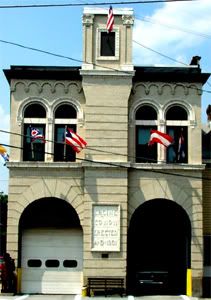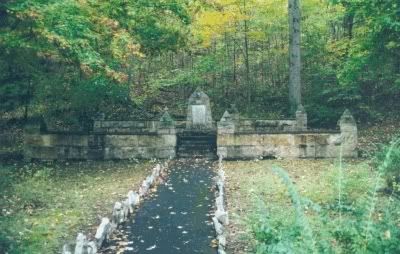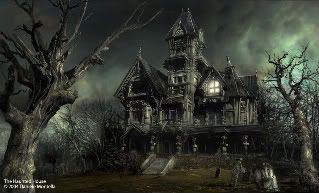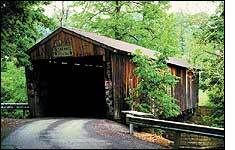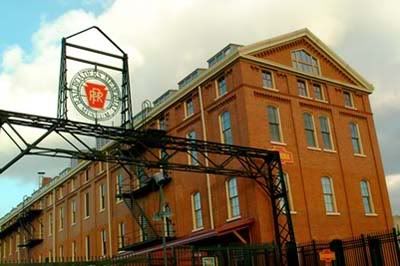
Image from the Chronicle of Higher Education
Nothing like a bunch of rich folk playing patty cake with the French maids to create a few spooks to haunt the halls of Pittsburgh's Chatham College in Shadyside.
Benedum Hall (“Graystone”): Originally, this was the home of The Great Wildcatter, oilman Michael Benedum and his wife Sarah, along with their son, Claude. Claude fell hard for the family maid, Maude. His parents disapproved, of course, and sent him off to the Army.
He died of pneumonia while in uniform in 1918 at the age of 20, and Maude joined him in the afterlife soon afterwards. It's said that they can be heard together playing footsies in the house. It became a dorm in 1960, and the mischievous Claude was known to pull the covers off sleeping students while filling the room with cigarette smoke.
A more malicious story involves Michael, who was said to be involved with a maid from the Rea household (more on them later) and got her pregnant. The enraged Sarah hung the maid from the Benedum's chandelier and tore the baby from her. It's said that sometimes you can still see the maid hanging from the chandelier in her black outfit, feather duster in her lifeless hand.
Other more mundane paranormal activity took place at Benedum. A former resident told us that she saw a spirit looking out her dormer window, and that "there were many other instances of people hearing parties in the main rooms with music playing and people laughing, shadows moving, etc."
Sadly for spook lovers, the college sold the Benedum property in 1986 and it's now the site of pricey town houses and condos.
Berry Hall: Now the admissions office, the building was once used as a dorm. It was built originally as a private residence in 1895. Students could hear the cries of children, and the speculation is they were youngsters that died while living in the house before the college took it over.
Fickes Hall: Built in 1927, the home was the residence of Edwin Stanton Fickes of Alcoa fame before becoming a dorm in 1946. It's ghosts include a woman that committed suicide by jumping out of a window (although readers Michele and her anonymous friend say she was talked back in, squelching that sighting), and the third floor is haunted by the spirit of a boy who fell out of a window.
Another reader, a student who lived on the third floor in the nineties, wrote to add "I frequently saw a female ghost in my room. She appeared to me several times a week, usually between 2:30 and 3:30 A.M. I never saw her until I moved my bed...under the two windows. Her appearances lessened significantly when I moved my bed to a different location. She was a very strong presence."
The main spook, though, is thought to be Fickes himself, who returns to his old suite of rooms every so often, rummaging through desks and closets and jumping in bed with the coeds, the old rake. Mellon's son lived there, too, and has to be considered an etheral suspect.
Gymnasium: The lights stay on in the gym even after you've shut them off. The athletic director isn't sure if the cause is electrical problems or just a friendly ghost keeping the gym open. Spooks have been known to have a basketball jones.
Laughlin House: The house was built in 1912, and it's now a dormitory. The grapevine has it that James Laughlin or James Rea hung themselves there. (They didn't. Julia Rea and Laughlin had a rumored affair, but it didn't end in anyone's suicide.) Laughlin House (Its' namesake is one of Jones & Laughlin Steel's founders, and grandfather of noted American poet James) is supposed to be the eeriest place at Chatham.
One former student told us she had her eeriest experience there: "The worst was a female spirit in Laughlin House (3rd floor). She had long dark hair and a bluish white dress, (and) she woke me up one night by putting intense pressure on my chest..."
Most phenomena experienced there are fairly traditional, with slamming doors, electrical devices turning on and off, ringing phones, opening and closing windows, running commodes and rearranged clothes and shoes. Some feel that the long ago affair cast a negative vibe over the house that can be felt to this day.
Mellon Center: Built in 1887, Andrew W. Mellon lived there for 20 years. There's a pool (now drained and used as a mechanical room) and bowling alley in the basement, and Mellon doesn't like to share them with the students, so he tries to shoo them away.
He's been seen walking across the pool area, but most of the sightings are in the bowling alley. Students can hear Mellon and Henry Clay Frick talking and listening to music. You can smell cigar smoke, and if the alley's closed, you can see the smoke coming out from behind the shut door. If you do bowl, the room is often cold.
The pins get into the act, too, sometimes resetting themselves so you can bowl another frame. There's some unspecified ghostly going-ons on the third floor. It's also said that the eyes of the portrait of Andrew Mellon in the lobby follow you around.
Rea House: This was also built in 1912. The ghost of a maid that had an affair with Andrew Mellon, or maybe Claude Benedum, makes her presence felt in the dorm. (No one's certain which one she did the dirty deed with. What is known is that she ended the affair by hanging herself in the dining room. We're not sure if she was the same maid hung in Benedum Hall or not. If not, same ending, different house.)
Allegedly, a woman's ghost walks through the front windows. There are also reports of crying babies, windows that never close, and some other poltergeist type activity. But for all its alleged history, many other students said that they've experienced nothing out of the ordinary.
Woodland Hall: This is where Chatham's most famous spirit lives, the “Blue Lady of Woodland Hall”. Students wake up with the vision of a woman hovering above them, dressed in a blue chiffon dress. But she shares the spotlight with the ghost of a young boy, who once grabbed a hapless student by the ankle while imploring her to play with him. The specter had a good grip; he left a bruise on her ankle. His haunt, the fourth floor, is always cold.
If you wonder how people from different mansions managed to meet discreetly for their various trysts, the answer is tunnels. Andrew Mellon, a lover of privacy, had various residences connected by underground tunnels (now closed; one reader said it went just from Benedum to Fifth Avenue) that were said to be wide enough to drive a carriage through. And once they got the maid in the back seat...
The school has held an annual Chatham Ghost Walk since 2005 to explore the haunted history behind Chatham’s residence halls.
